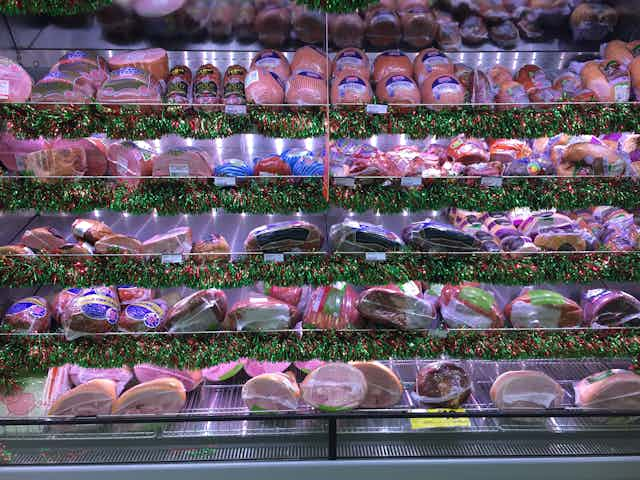Increasing interest in animal welfare means that there are a range of options for where your ham comes from this Christmas. What should you look for if you want to tuck into a ham from an ethically raised pig?
You’ll find hams from four main production systems on supermarket shelves this year: conventional hams, sow stall free, free range and “outdoor bred, raised indoor on straw”. So what do these labels mean?
Conventional hams
Conventional hams come from pigs farmed in intensive systems, where both sows (mother pigs) and piglets (the pigs that your Christmas ham comes from) are housed indoors.
Piglets are weaned at around three to four weeks of age. They are then housed in group pens on slatted or concrete floors (sometimes with straw or litter) until they are turned into ham and other pork products at around four months.
Some of the main animal welfare issues in intensive pig farming relate to the confinement of mother pigs. During their pregnancy, mother pigs are housed in “sow stalls”. These metal stalls are about the length and width of a fully grown sow and allow little movement.
Pigs are intelligent and social animals, and this confinement can cause stress and injury. There is evidence that other types of pig housing can also lead to stress and injury.
Before giving birth, sows are moved to a farrowing crate, where they remain until their piglets are weaned. Farrowing crates are designed to prevent mother pigs crushing the piglets. The mother pig has just enough room to lie down, meaning that her movement is severely restricted.
Sow stall free
Around 75% of pig production in Australia is now “sow stall free”, after the pork industry introduced a voluntary phase-out of sow stalls. Coles brand pork products are sow stall free, and Woolworths has committed to using stalls for less than 10% of the sow’s pregnancy (of around 115 days).
In some countries, including New Zealand, sow stalls have been totally or partially banned by law. They are also banned in the ACT.
Confusingly, “sow stall free” doesn’t mean that sows are free of all systems of confinement. Sows can spend up to five days in “mating stalls” after they have been mated (for Coles’ own brand products, it’s less than 24 hours). Sows are still housed in farrowing crates until their piglets are weaned.
Free-range
There are some free-range Christmas hams in the major supermarkets this year. However, just 5% of the Australian pig herd is free range.
In free-range systems, such as the RSPCA-approved outdoor system and Australian Pork Certified Free Range, both sows and piglets live outside in paddocks. They have access to shelters, wallows and shade.
Sows in these free-range systems aren’t confined in sow stalls or farrowing crates, and have the opportunity to express natural behaviours.
Most large-scale free-range pig production takes place in the south of Western Australia, which has ideal soil, water and climate conditions. Free-range pig farming is challenging in many parts of Australia, because of the hot climate.
Pig farming can also have environmental impacts. These include the degradation of soil and water systems through nutrient overload from manure.
You can buy free-range hams from farmers’ markets, specialist butchers and small-scale pig producers. When you buy at a farmers’ market, ask about how the pigs are raised and whether they are free-range.
Outdoor bred
There are a few hams around labelled “outdoor bred, raised indoors on straw”. These used to be labelled “bred free range”, until the ACCC took action against some producers using this label for misleading and deceptive conduct.
Hams with this label come from production systems where the sows live outside. They live under free-range conditions and are not confined to sow stalls or farrowing crates.
Piglets are born outside, but are moved inside after weaning and raised in group pens on straw or other litter, before being butchered for products including Christmas hams.
So what ham should I buy?
You can vote for better animal welfare by buying the most ethical ham you can afford, whether that’s a sow stall free ham from one of the major supermarkets or a free-range one from a small-scale producer at a farmers’ market.
Supermarkets are setting higher animal welfare standards for their own-brand pork products in response to increasing customer interest. These higher standards have the potential to influence new Australian Animal Welfare Standards and Guidelines for pigs, which are likely to be developed in the next few years.
Up to two-thirds of processed pork (including ham and bacon) is imported as boneless frozen pork. If you want to buy an Australian ham, look for ham on the bone, a label such as “Made from 100% Australian pork”, or the square pink “Australian Pork” label.
If you’re looking for an ethical ham that also scores on taste, check out the Good Food Christmas Ham Taste Test. Seven of the top ten hams were from free-range pigs.

